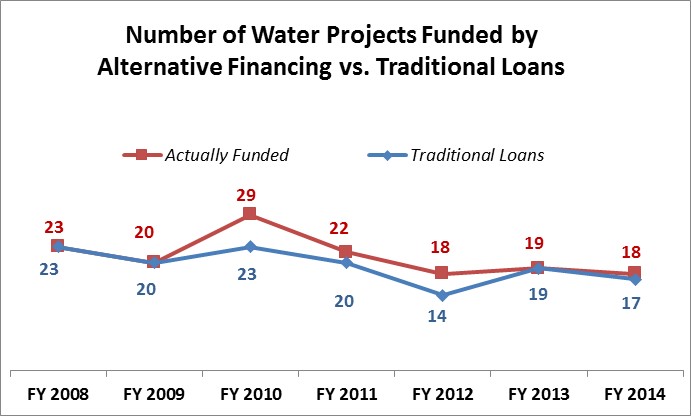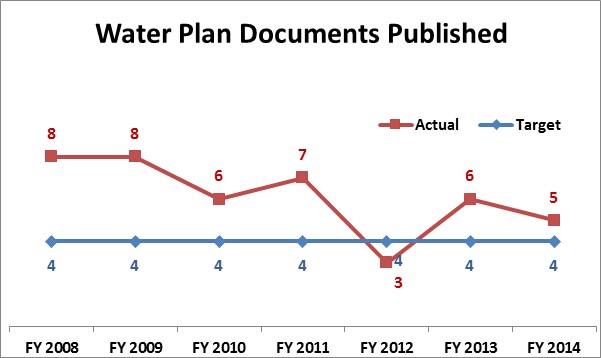Mission: Plan, conserve, develop and protect Utah's water resources.
Goals:
- Defend and protect Utah's rights to develop and use its entitlement to interstate streams.
- Continue state water planning activities to identify future water needs and to assist water entities to meet those needs.
- Provide technical and financial assistance to encourage the highest beneficial uses of water consistent with economic, social and environmental consideration.
- Promote weather modification research, evaluation and operational projects.
- Implement water education/conservation programs that encourage wise municipal, industrial, agricultural and environmental water use.
- Maintain accurate and current water supply and land use data for each hydrologic basin in the state.
During the 2015 General Session, the Legislature appropriated for Fiscal Year 2016, $18,152,300 from all sources for Water Resources. This is a 168.5 percent increase from Fiscal Year 2015 revised estimated amounts from all sources. The total includes $13,944,800 from the General/Education Funds, an increase of 388.1 percent from revised Fiscal Year 2015 estimates.
In addition to statewide compensation and internal service fund cost increases, the following appropriation adjustments were made during the 2015 General Session:
The following are the top measures chosen by division management to gauge the success of this division.
State law requires the Board of Water Resources to start using alternative methods of financing water projects, such as interest buydown and bond insurance purchases, in addition to the traditional loan financing.
Number of Water Projects Funded by Alternative Financing
Water Projects: The second measure compares the number of projects financed with alternative funding mechanisms with the number of projects that would have been funded with standard loans.

Water Plan Documents Published
Documents Published: This measure tracks the number of water plan documents published by the division. Those include the State Water Plan, river basin plans, and special reports on planning-related topics.

The division did not meet the target for the number of publications in FY 2012 because they combined the Southeast and Southwest Colorado Water Related Land Use Inventory Reports into one document.
The Division of Water Resources is the water resource authority for the state, assuring the orderly planning, development and protection of Utah's water. It does this through conservation, planning, participation in interstate streams negotiations and financial assistance programs (click on the link http://naturalresources.utah.gov/divisions/water-resources.html to go to the website).
WATER RESOURCES CAPITAL
Given that Utah has near the lowest annual precipitation of any state, residents throughout history have been compelled to adjust to limited water resources and to develop more water as growth continues. As the demand for water has grown, the Legislature has established various loan funds to provide funding for water development.
Five state boards currently direct the various water loan programs of the state. These are the Water Resources Board, the Water Quality Board, the Drinking Water Board, the Permanent Community Impact Board, and the Soil Conservation Commission. It has been estimated that state funding sources have been supporting approximately 20% of Utah water and wastewater development needs. All of the state water boards require water conservation plans as a condition of financing. The Natural Resources, Agriculture and Environmental Quality Appropriations Subcommittee oversees the Water Resources Board, the Drinking Water Board, the Water Quality Board and the Soil Conservation Commission.
The Water Resources Board manages three loan funds:
- The Revolving Construction Fund, established in 1947
- The Cities Water Loan Fund, established in 1974
- The Conservation and Development Fund, established in 1978
Beginning in FY 1998, legislation directed a portion of revenues from a 1/16 percent sales tax to be deposited in the Conservation and Development Fund (see Sales Tax Distribution Chart). More information on the use of the sales tax money can be found in the Conservation and Development Fund section.
The Water Resources Board has a goal to reduce the year 2000 per capita municipal and industrial water consumption in Utah by at least 25% before year 2025. If this can be accomplished, it would provide the same benefit as development of over 500,000 acre feet of water per year, savings estimated to be over $5 billion.
The operating budget for the Division of Water Resources is funded almost equally from the General Fund and transfers from the Conservation and Development (C&D) Fund.
COBI contains unaudited data as presented to the Legislature by state agencies at the time of publication. For audited financial data see the State of Utah's Comprehensive Annual Financial Reports.